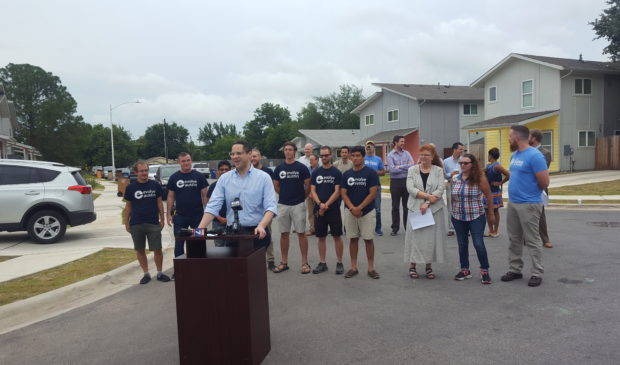Evolve Austin wants to make the case for density
Tuesday, June 20, 2017 by
Jack Craver A coalition of businesses and nonprofits hopes to mobilize people to support a new Land Development Code that will make Austin more compact and connected.
On Monday, Evolve Austin announced its plans for a yearlong grassroots campaign fueled by volunteer canvassers knocking on doors or soliciting people in public places. The goal is to raise awareness of CodeNEXT – the ongoing rewrite of the city code – and educate people on what Evolve views as the economical and environmental benefits of density and transit-oriented development.
Evolve’s stated mission is to fulfill the vision of Imagine Austin, the comprehensive plan adopted by City Council in 2012 that calls for denser development in the urban core to reduce suburban sprawl and to facilitate the use of public transit. The group is backed by a number of activist groups that support its environmental or affordability goals, such as Habitat for Humanity, Environment Texas and the Austin Justice Coalition, as well as by business groups that have an interest in simplifying or easing development regulations, notably the Real Estate Council of Austin, the Austin Board of Realtors and the Austin Apartment Association.
“There has truly never been a coalition as broad and diverse, working towards the same goal, as the one you see before you today,” said Evolve Executive Director Andy Cantú during a morning press conference in a Habitat for Humanity-constructed subdivision on Egger Street, in the Montopolis neighborhood.
CodeNEXT, explained Cantú, “is really where the rubber meets the road in terms of building the type of community that we want, not just for ourselves, but for generations to come.”
Getting people to understand the significance of city planning policy is not easy. Hence the plan to send canvassers “to talk to them about how the rules that govern the way we build and the way we develop impact their daily lives,” said Cantú.
Throughout this process, Evolve and others who support New Urbanist principles will almost certainly be competing with a counter-narrative about city planning pushed by neighborhood associations that view increased density as a threat to neighborhood character and argue that it won’t necessarily lower the cost of housing.
Indeed, while Cantú argued in an interview with the Austin Monitor that the current draft of CodeNEXT does not provide nearly enough additional housing in the urban core, neighborhood association leaders and some members of City Council have expressed concerns that the current draft will allow too much density in neighborhoods currently reserved for single-family houses.
Other Evolve speakers focused on different ways that the city, region and world would benefit from a denser urban core in Austin.
Wayne Gerami of Habitat for Humanity described how the organization that builds homes for low-income people has “largely been priced out of the city” due to the rising property costs. As a result, he explained, the city’s poor are increasingly getting pushed to the outer edges of the city or into surrounding communities, such as Bastrop, Elgin and Manor. The decreased cost of housing that former Austin residents may benefit from outside of the urban core is more than made up for by higher transportation costs and decreased economic opportunities, he said.
Robin Wilkins, who recently joined the Austin Tenants’ Council, described herself as a victim of Austin’s housing crisis, referring to her family’s recent displacement from a house whose value had skyrocketed over the last few years.
“Ultimately Austin needs more housing, not less,” she said.
Luke Metzger, founding director of Environment Texas, described densification as an important part of the fight against global warming. The car-centered, suburban lifestyle that people resort to as a result of sprawl results in the release of much greater levels of carbon dioxide, he said.
Heyden Black Walker, with Reconnect Austin, described the “human cost” of Austin’s car-dependent transportation system: scores of traffic fatalities each year and hundreds of life-altering injuries.
“The single most dangerous thing you can do with your child,” she said, “is drive him in a car.”
This story has been changed to correct a misspelled name.
Curious about how we got here? Check out the Austin Monitor’s CodeNEXT Timeline.
The Austin Monitor’s work is made possible by donations from the community. Though our reporting covers donors from time to time, we are careful to keep business and editorial efforts separate while maintaining transparency. A complete list of donors is available here, and our code of ethics is explained here.
You're a community leader
And we’re honored you look to us for serious, in-depth news. You know a strong community needs local and dedicated watchdog reporting. We’re here for you and that won’t change. Now will you take the powerful next step and support our nonprofit news organization?











